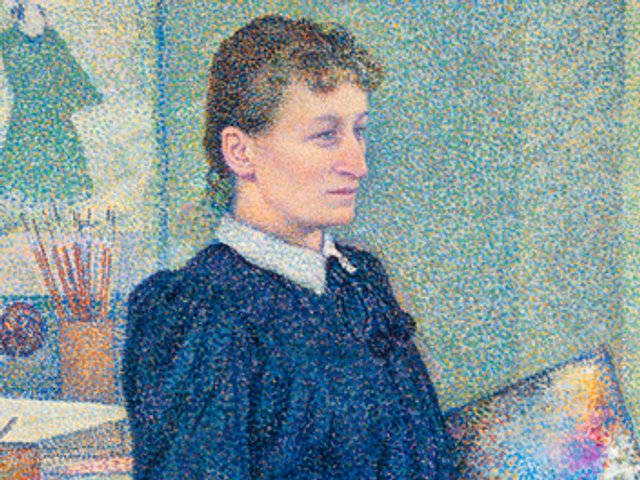One of Monet’s rare self-portraits, owned by the Musée Marmottan Monet in Paris, has been downgraded—and is now being attributed to an obscure Swiss artist, Charles Giron. The picture goes on show today at the Van Gogh Museum in Amsterdam with its new label, in a portraits exhibition entitled In the Picture: Portraying the Artist (until 24 May).
Behind the scenes, the long-running debate over attribution has been partly due to a dispute between the Wildenstein gallery, which gave the portrait to the Marmottan, and its previous owner, Paulette Howard-Johnston, the wife of a British admiral. On her death in 2009 at 104 she was the last living person to have known Monet.
Marianne Mathieu, the Marmottan’s curatorial director, told The Art Newspaper this week: ”Recent research, supported by previously unpublished documentation, now confirms the attribution to Giron.”
The unsigned portrait depicts Monet as a bohemian French artist, complete with beard and beret. Behind Monet hangs one of his 1884 French Riviera landscapes of Cap Martin. Curiously, the lower half of the painting is quite unfinished.
Although long labelled a self-portrait, the eyes averted from the viewer, the dangling cigarette and the arms resting on the thighs suggests it is of someone informally posing for a portrait. Stylistically, the flowing brushwork of the more finished areas is uncharacteristic of Monet’s work at the time.
In the October 2010 issue of The Art Newspaper we ran an investigative report saying that although exhibited by the Marmottan as a Monet, it was “not by him—the hunt is on to identify the mystery artist”.
Other attributions suggested by scholars include John Singer Sargent, Berthe Morisot, John Breck and Giron.
The portrait was originally owned by Monet, who hung it in his bedroom. In an unpublished letter, Howard-Johnston recalled seeing it there in 1925, when Monet told her it was “the picture of himself that he preferred”. She later inherited the painting, from her artist father Paul Helleu, but eventually sold it to the Wildenstein gallery New York in 1984.
The Marmottan later recorded that the portrait was donated by Wildenstein to the museum in 1986, although it was not displayed there or acknowledged until 2000. Its whereabouts during this interlude remain a mystery.
Wildenstein’s role was complex, since it was probably the major dealer handling Monet, while at the same time publishing the artist’s scholarly catalogue raisonné. In Wildenstein’s 1979 volume the picture was recorded as by Sargent. Charles Stuckey, a Monet specialist who questioned that attribution, has recalled that despite repeated requests in the early 1990s, Daniel Wildenstein had been “unable or unwilling” to discuss the painting with him or provide him with a colour reproduction.
In Wildenstein’s revised 1996 catalogue, a decade after the picture had been bought by Wildenstein, it was upgraded to a Monet—and proudly reproduced as a frontispiece. The 1996 catalogue coyly records that the painting was then in a “private collection”, although Wildenstein had supposedly already donated it a decade earlier to the Marmottan.
The scholar Joachim Pissarro (a great grandson of the Impressionist artist) argued in the December 2010 issue of The Art Newspaper that the painting was not a self-portrait, but a portrait by Giron (1850-1914), who was living in Paris in the 1880s.
Pissarro based this on a reference in Giron’s 1885 diary (published in the 1971 bulletin of the Musées de Genève), recording a visit to Giverny, where after lunch he spent an hour painting a portrait study, borrowing Monet’s own palette. Shortage of time probably explains why the lower part of the painting was not completed.
The uncertainty of attribution, which has worried Monet specialists for decades, was partly the result of a long-running legal wrangle between Howard-Johnston (and her heirs) and Wildenstein over the sale. As part of a settlement deal Daniel Wildenstein had apparently undertaken to donate the painting to the Marmottan.
This week Wildenstein responded to queries from The Art Newspaper by sending a detailed memorandum prepared for the gallery by New York art historian Joseph Baillio in 2011. He concluded that the painting is “an iconographical and historical document, and not an unfinished masterpiece by the greatest of the French Impressionists, Claude Monet”. Texts, scientific analyses and stylistic comparisons mean that it must be by Giron.
Although the portrait continued to be displayed at the Marmottan until a few years ago as by Monet, by 2018 the label had been changed to “attributed to Sargent”. Last year the portrait was taken off display. Today it goes on show in the Van Gogh Museum’s In the Picture, labelled in public for the first time as by Giron.
This leaves only two authentic Monet self-portraits. The first, done in 1886 (the year after the Marmottan portrait) and also depicting him in a beret, is in a private collection. The other, dating from 1917—and later given to Monet’s friend, prime minister Georges Clemenceau—is now in the Musée d’Orsay in Paris.
• For a report on the Amsterdam museum’s In the Picture exhibition, see today’s Adventures with Van Gogh blog by Martin Bailey.



